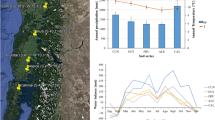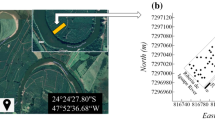Abstract
Purpose
The drainage of a riparian peatland interspersed with organic and mineral substrates in Northern Germany has led to subsidence morphology due to mineralisation, initial settlement and shrinkage processes causing cultivation problems and yield declines. To explain the relevancy of shrinkage to changes of the surface morphology and soil properties, organic and mineral substrates were analysed with regard to (1) shrinkage potential (i.e. the maximum shrinkage), (2) shrinkage curve, (3) actual in situ shrinkage and (4) irreversible shrinkage proportions.
Materials and methods
The investigated substrates are sedge peat, peat-clay, half-bog and alluvial sand of Fibric Limnic Histosols (Drainic) and a glacial clay for comparison. The methods used to obtain the shrinkage curves include the consideration of crack formation due to desiccation, as digital photography and image analysis were used in addition to height change measurements. To characterise the actual in situ shrinkage, continuous records of the soil matric potential for a 4.5-year period at two different intensively drained Histosols (moderately and deeply drained: mean groundwater table 0.6 and 1.7 m under ground level) were accomplished in four depths (15, 40, 70, 100 cm).
Results
The measured shrinkage potentials vary between 2% (alluvial sand) and 65% (peat-clay). The sedge peat and peat-clay are characterised by distinct higher shrinkage potentials compared to the glacial clay and show distinct proportional shrinkage. It has to be pointed out that the soil volume loss partly even exceeds the loss in water volume. The sedge peat does not reach residual or zero shrinkage but shows distinct structural shrinkage at initial desiccation. For the moderately drained site, matric potentials reached up to −60 kPa in summer in 15-cm depth, whilst capillary rise almost prevented desiccation of deeper zones. For the deeply drained site, summer desiccation reached deeper zones as well (matric potential up to −50 kPa in 40-cm depth) due to absent capillary rise. In the range of actually occurring maximum desiccation, the half-bog and peat-clay with high decomposed organic matter are particularly affected by shrinkage with volume decreases of 10–14%, in contrast to the fibred sedge peat with only 4%. When uniquely shrunken substrates will be re-wetted, distinct irreversible shrinkage proportions reaching between 18% and 31% subsequent to drying to a matric potential of −50 kPa and re-saturation were measured.
Discussion
Particularly, the organic-rich substrates appeared as characteristically sensitive to soil shrinkage. Contrary to mineral substrates, they lack in solid particles, leading, along with high hydraulic stresses due to dominantly finer pores, to intense volume decreases after desiccation. These substrates therefore partly also lack in residual or zero shrinkage, and the soil volume loss can even exceed the water loss due to shrinkage. Accordingly, the alterations of soil properties, e.g. conductivities, are especially pronounced.
Conclusions
The calculated proportion of actual in situ shrinkage (0.5 to 1 dm) to total subsidence of the investigated peatland is rather low for the deeply drained site in comparison to initial settlement (2–3 dm) and long-term active mineralisation (e.g. 4 dm in 40 years, mineralisation rate 1 cm year−1) but accelerates the latter because of enhanced aeration due to crack formation. Irreversible shrinkage is one reason why re-wetted fen peats do not retrieve their initial volume as well as their initial physical and hydraulic properties. Thus, a re-wetting of drained fen peats can only preserve the present condition.
Recommendations and perspectives
To impede the further impairment of riparian peatlands, it is necessary to maintain a near-surface water table particularly throughout the summer months, when high desiccation occurs, leading to a spatially differentiated proportion of initial settlement, shrinkage and mineralisation, causing subsidence morphology. Our recommendation is a drainage depth of less than 60 cm to enable pasture or grassland land use and to minimise mineralisation as well as structure formation in the (sub)soil.






Similar content being viewed by others

References
Allison LE (1986) Organic carbon. In: Klute A (ed) Methods of soil analysis: part 1. American Society of Agronomy, Madison, pp 1367–1378
Baumgartl T, Horn R (1999) Influence of mechanical and hydraulic stresses on hydraulic properties of swelling soils. In: VanGenuchten MT, Leij FJ (eds) Characterization and measurement of the hydraulic properties of un-saturated porous media. University of California, Riverside, pp 449–458
Baveye P, Boast CW, Ogawa S, Parlange JY, Steenhuis T (1998) Influence of image resolution and thresholding on the apparent mass fractal characteristics of preferential flow patterns in field soils. Water Resour Res 34(11):2783–2796
Blake GR (1986a) Bulk density. In: Klute A (ed) Methods of soil analysis: part 1. American Society of Agronomy, Madison, pp 374–390
Blake GR (1986b) Particle density. In: Klute A (ed) Methods of soil analysis: part 1. American Society of Agronomy, Madison, pp 371–373
Boivin P (2007) Anisotropy, cracking, and shrinkage of vertisol samples—experimental study and shrinkage modeling. Geoderma 138(1–2):25–38
Bonnett SAF, Ostle N, Freeman C (2006) Seasonal variations in decomposition processes in a valley-bottom riparian peatland. Sci Total Environ 370(2–3):561–573
Brandyk T, Szatylowicz J, Oleszczuk R, Gnatowski T (2002) Water-related physical attributes of organic soils. In: Parent LE, Ilnicki P (eds) Organic soils and peat materials for sustainable agriculture. CRC, Boca Raton, pp 33–62
Braudeau E, Costantini JM, Bellier G, Colleuille H (1999) New device and method for soil shrinkage curve measurement and characterization. Soil Sci Soc Am J 63(3):525–535
Bronswijk JJB (1988) Modeling of water-balance, cracking and subsidence of clay soils. J Hydrol 97(3–4):199–212
Bronswijk JJB (1989) Prediction of actual cracking and subsidence in clay soils. Soil Sci 148(2):87–93
Bronswijk JJB (1991a) Drying, cracking, and subsidence of a clay soil in a Lysimeter. Soil Sci 152(2):92–99
Bronswijk JJB (1991b) Relation between vertical soil movements and water-content changes in cracking clays. Soil Sci Soc Am J 55(5):1220–1226
Bronswijk JJB, Eversvermeer JJ (1990) Shrinkage of Dutch clay soil aggregates. Neth J Agr Sci 38(2):175–194
Camporese M, Putti M, Salandin P, Teatini P (2005) Modeling swelling/shrinkage behaviour of peat soils. Geophysical Research Abstracts 7(07991)
Camporese M, Ferraris S, Putti M, Salandin P, Teatini P (2006) Hydrological modeling in swelling/shrinking peat soils. Water Resour Res 42:W06420. doi:10.1029/2005WR004495
Chertkov VY (2005) The shrinkage geometry factor of a soil layer. Soil Sci Soc Am J 69(6):1671–1683
Chertkov VY, Ravina I, Zadoenko V (2004) An approach for estimating the shrinkage geometry factor at a moisture content. Soil Sci Soc Am J 68(6):1807–1817
Dekker LW, Ritsema CJ (1996) Variation in water content and wetting patterns in Dutch water repellent peaty clay and clayey peat soils. Catena 28(1–2):89–105
European Soil Framework Directive (2006) Proposal for a directive of the European parliament and of the council establishing a framework for the protection of soil and amending directive 2004/35/EC. p 30
FAO (2006) Guidelines for soil description, 4th edn. FAO, Rome, p 110
Freibauer A (2003) Regionalised inventory of biogenic greenhouse gas emissions from European agriculture. Eur J Agron 19(2):135–160
Garnier P, Perrier E, Jaramillo RA, Baveye P (1997a) Numerical model of 3-dimensional anisotropic deformation and 1-dimensional water flow in swelling soils. Soil Sci 162(6):410–420
Garnier P, Rieu M, Boivin P, Vauclin M, Baveye P (1997b) Determining the hydraulic properties of a swelling soil from a transient evaporation experiment. Soil Sci Soc Am J 61(6):1555–1563
Gebhardt S, Fleige H, Horn R (2009) Effect of compaction on pore functions of soils in a North German Saalean moraine landscape. J Plant Nutr Soil Sci . doi:10.1002/jpln.200800073
Gee GW, Bauder JW (1986) Particle-size analysis. In: Klute A (ed) Methods of soil analysis: part 1. American Society of Agronomy, Madison, pp 383–411
Göttlich K (1990) Moor- und Torfkunde. 3. vollst. überarb. und erw. Aufl., Stuttgart
Groenevelt PH, Grant CD (2001) Re-evaluation of the structural properties of some British swelling soils. Eur J Soil Sci 52(3):469–477
Groenevelt PH, Grant CD (2004) Analysis of soil shrinkage data. Soil Till Res 79(1):71–77
Hennings HH (1996) Zur Wiedervernässung von Niedermoorböden. Dissertation, Georg-August-Universität, Göttingen
IUSS Working Group WRB (2007) World reference base for soil resources 2006, first update 2007. In: World Soil Resources Reports No. 103. FAO, Rome
Kasimir-Klemedtsson Å, Klemedtsson L, Berglund K, Martikainen P, Silvola J, Oenema O (1997) Greenhouse gas emissions from farmed organic soils: a review. Soil Use Manage 13(4):245–250
Kennedy GW, Price JS (2004) Simulating soil water dynamics in a cutover bog. Water Resour Res 40(12):1–13
Kennedy GW, Price JS (2005) A conceptual model of volume-change controls on the hydrology of cutover peats. J Hydrol 302(1–4):13–27
Kim DJ, Vereecken H, Feyen J, Boels D, Bronswijk JJB (1992) On the characterization of properties of an unripe marine clay soil.1. shrinkage processes of an unripe marine clay soil in relation to physical ripening. Soil Sci 153(6):471–481
LANU (2002) Programm zur Wiedervernässung von Niedermooren. Landesamt fuer Natur und Umwelt, Schleswig-Holstein
McGarry D, Malafant KWJ (1987) The analysis of volume change in un-confined units of soil. Soil Sci Soc Am J 51(2):290–297
McLay CDA, Allbrook RF, Thompson K (1992) Effect of development and cultivation on physical-properties of peat soils in New-Zealand. Geoderma 54(1–4):23–37
Mitchell AR (1992) Shrinkage terminology—escape from normalcy. Soil Sci Soc Am J 56(3):993–994
Oleszczuk R, Bohne K, Szatylowicz J, Brandyk T, Gnatowski T (2003) Influence of load on shrinkage behavior of peat soils. J Plant Nutr Soil Sci 166(2):220–224
Pendleton DE, Dathe A, Baveye P (2005) Influence of image resolution and evaluation algorithm on estimates of the lacunarity of porous media. Phys Rev E 72(1):041306.1–041306.9
Peng X, Horn R (2007) Anisotropic shrinkage and swelling of some organic and inorganic soils. Eur J Soil Sci 58(1):98–107
Peng X, Horn R, Peth S, Smucker A (2006) Quantification of soil shrinkage in 2D by digital image processing of soil surface. Soil Till Res 91(1–2):173–180
Peng X, Horn R, Smucker A (2007) Pore shrinkage dependency of inorganic and organic soils on wetting and drying cycles. Soil Sci Soc Am J 71(4):1095–1104
Richter FH, Fleige H, Blume HP, Horn R (2007) Bodengesellschaften von geomorphen Einheiten unter Berücksichtigung des Gefügestils im Stormaner Jungmoränengebiet (Brandenburger Stadium) in Nordwestdeutschland. J Plant Nutr Soil Sci 170:682–692
Sauerbrey R, Zeitz J (1999) Moore. In: Blume HP (ed) Handbuch der Bodenkunde. Ecomed, Landsberg
Schindler U, Mueller L, Behrendt A (2003) Field investigations of soil hydrological properties of fen soils in North-East Germany. J Plant Nutr Soil Sci 166(3):364–369
Schlotzhauer SM, Price JS (1999) Soil water flow dynamics in a managed cutover peat field, Quebec: field and laboratory investigations. Water Resour Res 35(12):3675–3683
Scholz M, Trepel M (2004) Water quality characteristics of vegetated groundwater-fed ditches in a riparian peatland. Sci Total Environ 332(1–3):109–122
Schothorst CJ (1977) Subsidence of low moor peat soils in western Netherlands. Geoderma 17(4):265–291
Schwärzel K, Renger M, Sauerbrey R, Wessolek G (2002) Soil physical characteristics of peat soils. J Plant Nutr Soil Sci 165(4):479–486
Smiles DE (2000) Hydrology of swelling soils: a review. Aust J Soil Res 38(3):501–521
Zeitz J, Velty S (2002) Soil properties of drained and rewetted fen soils. J Plant Nutr Soil Sci 165(5):618–626
Author information
Authors and Affiliations
Corresponding author
Additional information
Responsible editor: Winfried Blum.
Rights and permissions
About this article
Cite this article
Gebhardt, S., Fleige, H. & Horn, R. Shrinkage processes of a drained riparian peatland with subsidence morphology. J Soils Sediments 10, 484–493 (2010). https://doi.org/10.1007/s11368-009-0130-9
Received:
Accepted:
Published:
Issue Date:
DOI: https://doi.org/10.1007/s11368-009-0130-9



